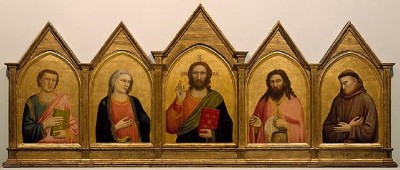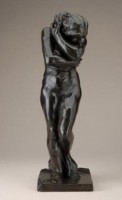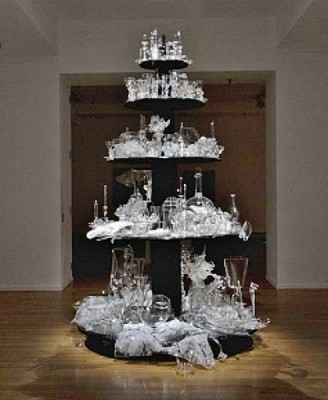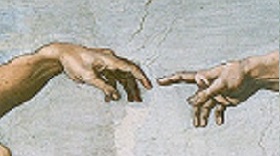A Visit To The Museum
I visited the North Carolina Museum of Art today; not for any particular exhibit or show but just for inspiration I guess, just to see some texture, some paint on canvas by those who are good at putting it there. It is, I might add, fascinating to walk through a museum and see the progression of art, from country to country, era to era.
I made some notes, had some thoughts; here they are, per individual work viewed, with descriptions from NCMA when provided.
Please remember that what’s been on my mind lately is the proverbial question of what “Art” (with a capital “A”) is, specifically, what art is for me–for my personal work, i.e., where am I going with my painting, what do I want them to look like, to be. I seem to have plenty to say through my work but how do I want my voice to appear, I guess is my thought stream.
The work: Doors Of Jerusalem by Jaume Plensa, 2006.
From NCMA: “Song of Solomon/Song of Songs, names of the eight gates to the walled city of Jerusalem. This is a series of three huge, crouched figures glued high above to different walls. The figures have letters on them depicting the gate’s names.”
My thoughts: Ok, this could be “A”rt? The figures are done well enough, anatomically correct enough for what the piece is doing. They are crafted well enough–I don’t wince over their construction–and they are attempting to say, something, though I don’t think the museum was exactly sure what it was, just that it had to do with a woman pacing the wall at Jerusalem, waiting for true love, or something like that from the biblical story. I know I don’t know what it is about and not being familiar with the biblical story left me cold to the thing except that it was large, and the material was interesting–a translucent polymer type stuff.
The work: Lines That Link Humanity by El Anatsui, 2008.
My thoughts: Site Responsive. Another piece showcasing “found” objects but, in this case, they are relevant to what the artist is saying–about the trading of alcohol for people in this land he is from. It’s a large wall of colored objects–from alcoholic beverages for the most part. Is this Art? Who am I to even question it? I have every right and I’m as qualified as any to say what art is for me. What caught my attention here was the idea, and fact, that this piece is “site responsive”, meaning that the work was created on, specifically for, and influenced by, the site where it would ultimately rest.
The work: The Peruzzi Altarpiece by Giotto di Bondone, circa 1310-1315.
My thoughts: I understand Giotto’s influence on the Renaissance but to me the work resembles that of one not sure of what they are after, of one reaching out for one thing and at the same time holding onto, or being held back to, something else–something known and accepted.
“Convention kills the spirit.”
Compare this with African art or any stylized era, when there is sureness of what the goal is, of the stylistic intentions. Giotto reminds me of me, trying to figure out realism, or illusionism. He is between two worlds, the symbolic convention of his time, and the illusionism of the future. Convention kills the spirit.
The work: Veil of Veronica by Agostino Cornacchini.
My thoughts: My grandmother, on my mother’s side, a spiritualist of the spiritualist movement of the early 20th century, said that I was born with a “veil”. My mother relayed this to me but didn’t know what she meant by it; nor do I. But when I read the title of this work it, of course, slowed my gait.
It is of a child holding a small kerchief that has the three dimensional impression of a face. From Ask.com, “The Veil of Veronica, or Sudarium (Latin for sweat-cloth), often called simply “The Veronica” and known in Italian as the Volto Santo or Holy Face (but not to be confused with the carved crucifix Volto Santo of Lucca) is a Catholic relic of a piece of cloth, which, according to legend, bears the likeness of the face of Jesus not made by human hand.”
The work: Eve by Rodin, 1883.
My thoughts: There is absolutely no question in my mind that what I am looking at is pure magnificence in Art. Why is this? Because the figures, though they represent reality, transcend it. They are something to behold, truly something that one cannot explain.
Now if you compare these works to the Greeks, you see the absolute reality of the movement in Rodin’s work, not so much in the former. It’s a bit kin to looking at Rembrandt vs. others of his time; there is a life force running thru the work. It is a marvel to behold.
I read, and saw, that Rodin moved away from this “realism” into an abstraction of sorts. It prompts me to ask, what is it that makes me say something, in a certain way, with my art? Are they completely correlated–the why, what and how? Is this the rub– that I hold onto what I know/think to be Art (back to Giotto) and forge my vision from that (vision being a separate thing from voice–vision is the image of the voice). Or does form follow my voice?
The work: Bride by Beth Lipman, 2010.
From NCMA: “the five-tiered, 10-foot-tall glass sculpture”
My thoughts: I kept trying to give this piece the benefit of the doubt but kept coming to the same conclusion over and over, that being that this is ridiculous. And I hate to say that out loud because I’m talking about an artist, someone that has put herself out there. I asked a museum guard strolling by if this was art. He said, “all I know is that the museum paid for it.” I kept wishing there would be a Rodin there instead.
I think my visit today to the museum has helped me narrow down my search for Art and my search for my own art. I was able to identify definitely what was, and what was not, “A”rt (to me anyway) and then some things in between. Maybe that’s the answer to the question, like there are gradations of all kinds of things–bad to great athletes, music, etc., maybe Art is all of the scale of creative activity whether truly worthy in one’s mind or not. So the question changes from “what is Art”, to “what is great Art”. Some would say that great art is that art that should begin with a capital “A”.
Anyway, for myself, I will go forth with more confidence now. I’ve seen again that the artist uses his brush to carve out meaning for himself. He is ever searching, and that’s a good thing.
I learned about myself also, for better or worse, that I judge first the technique of the artist, i.e., how well it was produced, if at first I can’t see it as a composite, an amalgam of beauty. In other words, beauty (whatever that is) is my first response, if I don’t see that then I turn to technique for evidence of the legitimacy of the artwork.
I also commented on this subject at The Capital Gazette.






















A lot of people are afraid to state their opinion on art because they don’t want to sound ignorant. They fail to realize that art is what it is to them – a personal experience. So I commend you for your bravery and putting your thoughts out there for people like me to enjoy.
I was quite entertained by your reaction to “Bride” by Beth Lipman. I felt your frustration and I do agree with you that Rodin’s sculpture would have been a better choice. However, after examining the photo closely, here is what I see . The artist is speaking about the fragility of what it is to be a bride. The societal expectations and peer pressure. The sculpture obviously looks like a wedding cake. Each layer representing a phase/stage in life – Childhood (full of possibilities and abundance), Young Adulthood (self awareness leading to lesser possibilities), Adulthood (lesser possibilities), Middle Adulthood (limited possibilities), Late Adulthood (downsized lifestyle) and finally old and alone (with no place to hide). Edvard Munch’s “Women in three stages” comes to my mind.
Edvard Munch is right up my alley. I do relate to the German Expressionists which may be a bad thing because some see them as a bit depressing. In the case of Bride, no matter how profound and deep the statement, as you say, give me Rodin any day, or even Munch for that matter. For me, visual Art is visual first.
I hear you. I feel similarly about “Onement VI” by Barnett Newman. The term dissonance comes to mind. A close friend of mine loves it. That makes it even worse. LoL!
Art is in the eye of the holder of the wallet I guess. I offer this link to Sotheby’s auction record on the piece you mention if anyone is interested. BARNETT NEWMAN 1905 – 1970 ONEMENT VI